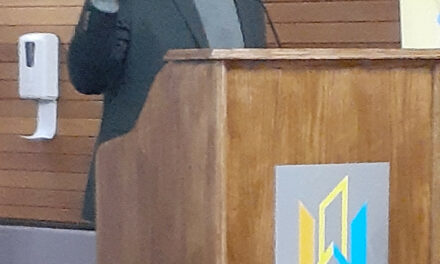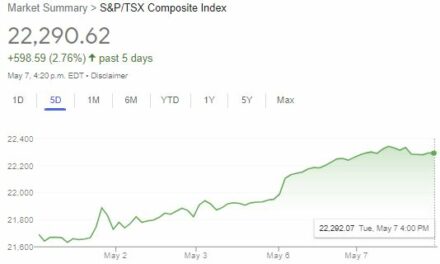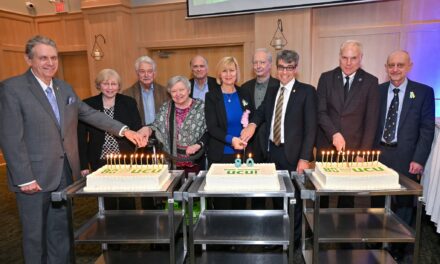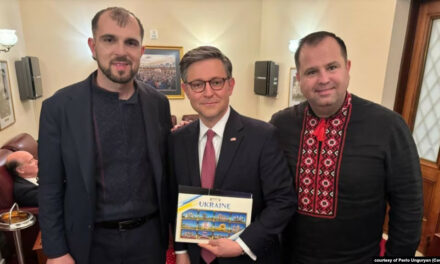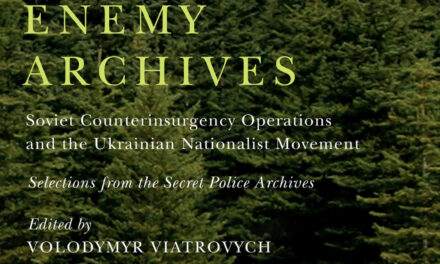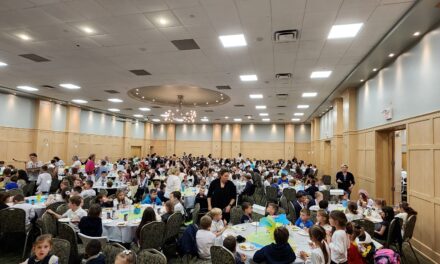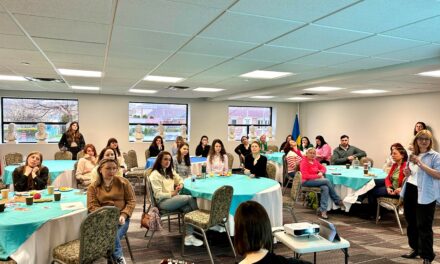Lidia M. Wasylyn, Edmonton.
A taste of seventy years of collecting, documenting and preserving, was displayed at the opening of That Old Sheepskin Coat — Toi Staryy Kozhukh, a 70th anniversary exhibit, of the Ukrainian Catholic Women’s League of Canada (UCWLC) Museum, on October 2, 2022. The event also honoured the 130th Anniversary of Ukrainian immigration to Canada and took place at St. Josaphat Ukrainian Catholic Cathedral in Edmonton.
A well planned, interesting program provided background on the museum and its vast collection. The large variety of items well displayed in the Cathedral’s basement hall represented only about 20% of the museum’s entire collection. These items included numerous and varied articles of men’s and women’s clothing, including headwear, khustky, poyasy, an array of rushnyky, pillows, leather goods, and accessories of all kinds. Examples of the many Ukrainian embroidery stiches were beautifully displayed as framed art with informative descriptions. A stunningly beautiful kylym originating from the Shklanka Family of Saskatchewan was also displayed.
The afternoon’s program was opened by Joyce Chrunik-Rudiak, chair of the Eparchial Museum Committee. First introduced was Bishop David Motiuk, Eparch of Edmonton and Apostolic Administrator of the Eparchy of New Westminster. In his prayer he said: “Loving Lord, You are the author of all creation and all beauty as we celebrate the 70th anniversary of the museum of the UCWLC Eparchy of Edmonton and 130 years of Ukrainian immigration and settlement in Canada. We ask that You enrich our minds and hearts with the wisdom and beauty of the ages. Help us to grow in our understanding of Your goodness and love as this museum tells the story of the ages of a people who came to new lands and rooted themselves in their faith and culture. Bless the museum that it may record not only the past but help our peoples to understand our identity and purpose in life, and in faith, as You have given. Thereby making the museum a living museum, whereby our children and grandchildren and all may be proud of our spiritual and historical patrimony, so that we in turn may bless You and Your people for generations to come. So loving Lord, bless all those who visit this museum. That our ears, our hearts, and our minds may be open to Your goodness. Bless also the UCWLC, its museum curators and volunteers that they may be rewarded in their work with good faith, good health, many years, and salvation. We ask this in Your name, that of the Father, the Son, and the Holy Spirit. Slava Isusu Khrystu.”
As explained by Chrunik-Rudiak, the exhibit theme, “That old sheepskin Coat,” came from a song of the same name recorded by the Ukrainian Male Chorus of Edmonton. The song was inspired by a photo taken by Gordon Gordey who later explained the song’s back story. Gordey is an accomplished personality in Edmonton’s arts community and internationally. He is most closely associated with the Shumka Dancers with 42 years of involvement including 10 years as their artistic director. Gordon is an 8-year board member and currently First Vice President of the Ukrainian Canadian Foundation of Taras Shevchenko. He recently spearheaded the Shevchenko Foundation’s grant and scholarship programs to support Ukrainian newcomers to the Ukrainian creative community who find themselves displaced in our Canadian communities. Among them are young aspiring musicians, dancers, artists, and creative culture makers. Gordon looks to them to challenge the diaspora to embrace the birth of a new dynamic cultural expression inspired by our ancestral homeland Ukraine.
Gordon Gordey was a very engaging and entertaining keynote speaker. He noted the translation “That Old Sheepskin Coat” may be correct but “everyone who has even a slight knowledge of our Ukrainian language knows that the translation doesn’t embody what ‘Starej Kozhooh’ means to every one of us.” He explained that “It’s not all positive. For others, Sir Clifford Sifton’s statement: “I think a stalwart peasant in a sheepskin coat, born on the soil, whose forefathers have been farmers for ten generations, with a stout wife and a half-dozen children, is good quality.” The settling of Canada brings accounts of discrimination and the subsequent perseverance of Ukrainian immigrants to fight and build our identity as Canada’s nation builders.

Speakers at the Anniversary Celebration. Left to Right: Gordon Gordey, Nadia Cyncar, Joyce Chrunik-Rudiak, Radomir Bilash, Viktoriia Bondarenko and Bishop David Motiuk
Gordey further stated, “There is an irony that in the late 1960s, sheepskin coats were part of the height of “hippy culture”. To prove it here is my wife Cathie’s “hippy sheepskin” coat from 1969 bought at Henry Singer’s. If you were with it – you wore a sheepskin coat on the streets of London, Rome, and Edmonton.”
Gordey shared the interesting back story of the song “Toi Staryy Kozhukh.” The Edmonton Ukrainian Centennial Male Chorus collaborated with composer Willi Zwozdesky to write the choral and piano arrangements to the music written by the late Gene Zwozdesky with the lyrics penned in Ukrainian by the late Anna Zwozdesky and later translated into English by Gene. The song was performed for the 100th anniversary of Ukrainian settlement and then recorded in 1992.
Guests were treated to a stirring music video of “Toi Staryy Kozhukh” performed by the Edmonton Men’s Choir, depicting authentic photos of early immigrants to Canada showing their lives, their families, their work, and culture. In addition to the video, on display was the inspirational photograph of a staryy kozhukh taken by Gordey. For historical authenticity, the photo was taken on the site of a 1930’s community livery stable in Spedden, Alberta built by Gordey’s wife’s Dido. The violin belonged to Gordey’s Dido and the mandolin belonged to his mother.
It is important to note, Gordey shared that “At the Shevchenko Foundation we have recently re-written our grant programs for Collections Management and Exhibitions. Our support statement reads: The Collections Management and Acquisitions Sector provides support to organizations and institutions with permanent collections such as archival repositories, museums, libraries and art galleries to collect, study and preserve material and intellectual capital of Ukrainian Canadian cultural heritage, including history, ethnology, folk art, fine art and archives.
The Exhibits and Related Programs Sector of the Heritage Pillar provides project support to groups, organizations and institutions for the creation of public exhibitions of museum and archival collections related to the history of Ukrainians in Canada.

Gordon Gordey’s inspirational photo of a kozhukh on a old building in Spedden, AB
The enormous contributions of the museum’s long-time volunteers and curators were acknowledged. Special thanks and floral presentations were made by Chrunik-Rudiak. First, to long-time museum curator Nadia Cyncar who has been a dynamic and indomitable force throughout the museum’s history and long-time museum committee chair, Evelyn Cook who has been a calm and steadfast leader. Current committee members were also acknowledged and introduced. They included Luba Baziuk, Janette Bayduza, Nadia Cyncar, Jean Kowal, Lana Kukhar, Mary Ann Phillips, Iris Semeniuk, Helen Sirman, Joyce Sirski-Howell, Oksana Tarnawska, Helen Tymoczko and Maxine Zakordonski.
A brief history of the museum’s 70-year path to today was presented by Joyce Sirski-Howell. This was followed by a delightful mini ethnographic study about the kozhukh, presented by Lana Kukhar, Curator’s Assistant. She highlighted interesting traditions, folk beliefs and practices involving the kozhukh. It is fascinating how a mundane, utilitarian item of clothing, designed to keep one warm in the cold has such rich significance in various aspects of life. The kozhykh performed many ritual functions, starting with birth, continuing throughout life, and ending with one’s passing. Lana noted that references to the kozhukh are found in Ukrainian folk songs and sayings, especially in lullabies, where the kozhukh symbolizes comfort and peace for a child.
To honour the 130th Anniversary of Ukrainian immigration to Canada, a children’s colouring book was created in cooperation with the UCWLC and launched during the exhibit. The illustrator is Viktoriia Bondarenko, who fled the Odesa Region of Ukraine in April 2022 and currently makes her home in Edmonton. The colouring book was co-authored by Radomir Bilash, who was also the translator and content consultant along with, Chrunik-Rudiak who served as project coordinator. Additional editorial assistance was provided by Barb Olynyk, Joyanne Rudiak-Longhurst, Rena Hanchuk and Yaroslav Kitynskkyy. The publication was funded, in part, by The Shevchenko Foundation, Ukrainian Canadian Veteran’s Fund.
Lovely background piano music performed by talented pianist, conductor and musician Irena Tarnawska added to the happy and relaxed atmosphere at the exhibit.
Share on Social Media









